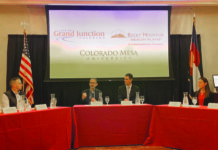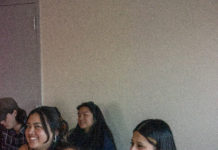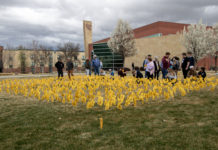Nearly two weeks apart, two Colorado Mesa University students were struck at the same crosswalk under very similar circumstances, now, CMU and the City of Grand Junction are asking how they can prevent it from happening again.

Chris Walker, a track and field thrower, and McKayla Moore, a 20-year-old CMU student, were both struck by cars at the same crosswalk, on 12th Street and Mesa Avenue while riding their bikes. While Walker sustained little injury, Moore was transported by ambulance to the hospital following her collision.
Moore could not be reached for comment despite repeated attempts. Her injuries were expected to be non-life threatening by the Grand Junction Police Officer on the scene.
These two incidents have prompted a conversation between the City of Grand Junction and the university. Grand Junction Transportation Engineer, Paul Jagim and Colorado Mesa University Director of Campus Safety and Student Conduct, Pua Utu spoke on Oct. 19 about possible steps to resolve the issue.
“We’re going to reevaluate the setup that is out there now, the current signage and flashers,” Jagim said.
On the stretch of 12th Street next to the CMU campus, there are three designated crosswalks with flashing yellow beacons. Jagim said that while the current system of signs and beacons does meet national standards and requirements, they are not the newest version.
“One thing we are looking into is: can we acquire the funding necessary to upgrade the flashers adjacent to the campus to that more high-intensity flasher that uses LED lights?” Jagim said.
This type of LED beacon can be seen at the crosswalk further down 12th Street near Stocker Stadium and may prove to be more noticeable for oncoming drivers.
Colorado and Grand Junction law may allow for bicyclists to ride on sidewalks; however, it requires they dismount before entering any crosswalk. Jagim is considering the addition of signs that instruct bicyclists to dismount before they cross, an action that some students asked for following Walker’s collision.
“None of these kids get off their bikes; it’s dangerous,” Jackson Freismuth, Walker’s roommate said following the crash in September. “Some public awareness would be especially cool.”
Despite Walker being hit on his bike, he was still partially at fault for not dismounting before crossing and was cited for such.
“There’s no signs. I’ve never seen one person get off their bike,” Eli McMillan, another roommate of Walker, said in September as well.
Signs that instruct bicyclists to dismount before entering the crosswalk are available in downtown Grand Junction, along Main Street.
“It’s been an observed concern for some time now that the tendency is that the pedestrian or the bicyclist that’s crossing the street isn’t allowing much time between when they push the button and when they enter the street,” Jagim said.
Due to this, bicyclists are struck by oncoming cars who are not expecting a cyclist entering the roadway.
Jagim cannot promise that signage changes are needed until he visits the site firsthand, and due to funding restrictions, pedestrians, bicyclists and motorists may not see real change until 2018.
However, it may not be as simple as a sign to prevent further collisions. According to KKCO, Grand Junction Police Department reported 54 accidents involving bicycles this year, up from 42 in 2016.
“Signs, generally speaking, are not terribly effective because they’re just a sign that people can choose to ignore, but it’s definitely something we’re looking into doing,” Jagim said.
The inherent issue, Jagim and Utu agreed, is that college students may not be exercising the same caution that was instilled in them when they were younger.
“It’s kind of a human nature thing that kids are taught real well to look both ways to make sure that you don’t step out in front of a car,” Jagim said. “It’s a bit of a frustration that college kids are not always that cautious.”
Education may be a more effective agent of change, Utu and Jagim believe.
“I think what we’re trying is just additional options to help,” Utu said. “The simple truth to this is both the pedestrian, bicyclist and the motorist needs to be aware that they are approaching a sensitive portion of the roadway.”
A possible route to do so could be an educational public relations campaign, Jagim says. However, the City of Grand Junction cannot do it alone.
“We’re going to need help from the campus to do that,” Jagim said. “That could take a few months to get rolling, it’s hard to say.”
Utu and Jagim both stressed the importance of caution that students should exercise before entering the roadway. Dismounting from a bicycle before crossing, waiting for vehicles to come to a complete stop and making eye contact with motorists are key steps to prevent further collisions.





